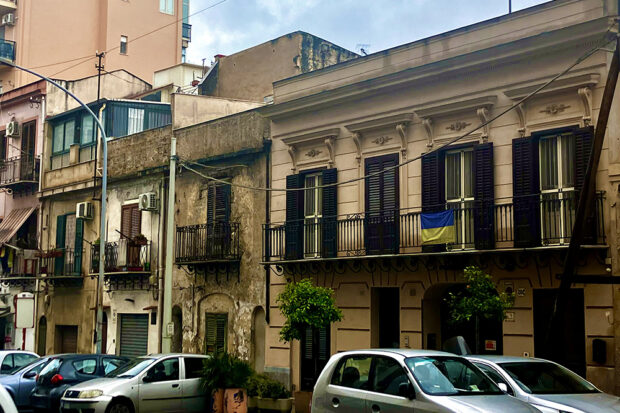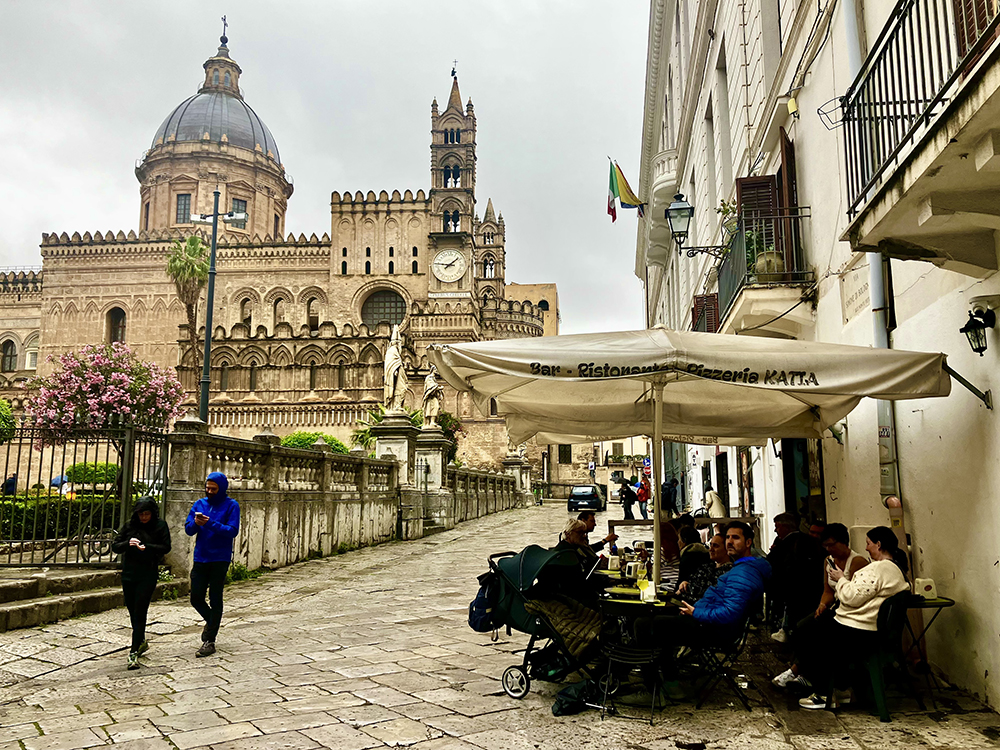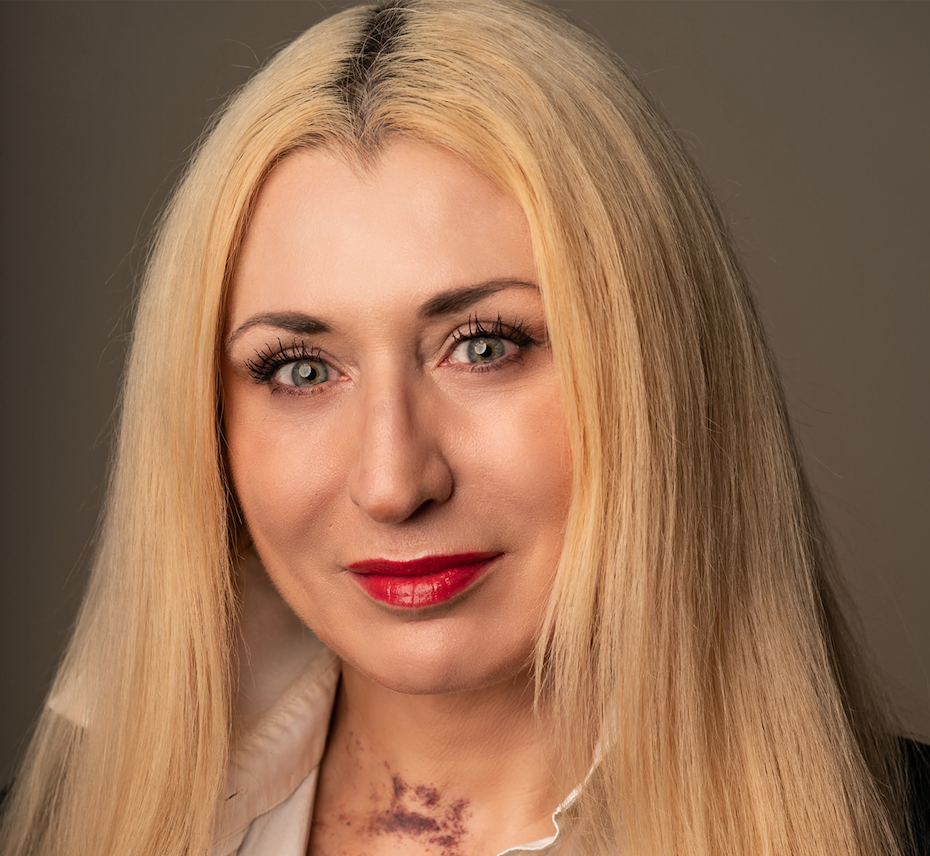
On Feb. 24, 2022, Olha was planning to take her 13-year-old cat Busynka to a vet for chipping and vaccination as they would have to flee Ukraine. The war could start at any moment.
Living in Sievierodonetsk, Luhansk region, in Donbas, and having witnessed the Russians attacking her native lands since 2014, Olha was prepared. Yet, when explosions woke her up at 4 a.m., she didn’t want to believe the war started.
She stayed in bed, pulling the blanket over her head, trying to fall asleep again. By 7 a.m., she got up and rushed to the gas station where a long line of cars formed. She was lucky to get a full tank—in a few hours, no gas was left.
Olha could flee, but she didn’t want to. Her daughter, 24, moved out and was safe in western Ukraine. Her mother, youthful and energetic at 65, living in nearby Lysychansk, did not need help.
Olha had just renovated her apartment, installing a fancy new balcony, and was finally free to travel, take professional growth classes—she was a passionate hairstylist—and just enjoy life.
For the first few days, she moved to her friend’s parking garage with her Busynka, the cat. Her friend Katya also had a cat, and they fixed an improvised underground home. The cats first fought but soon figured out a way to make peace.
The noise from explosions and the walls shaking were getting worse. The Russian military was getting closer. Olha called her ex; despite a back injury, he enrolled in the Ukrainian army.
“You must leave,” he said. “Immediately.”

He told her which streets to avoid on the way out of town as the territory was heavily mined. Driving on the lawns, with an elderly lady from the neighborhood and cat Busynka in the back sitting quietly, Olha got out of the city and drove for 700 kilometers. The older lady was on the phone with her friends in Poland, giving directions.
All refugees in Ukraine were offered temporary lodging in schools and gyms. One time, they slept in the car at a gas station, in an endless line of cars.
At one block post, Olha didn’t brake on time and had a gun pointed at her as the Ukrainian military were screening for saboteurs.
In a few days, Olha reached Poland, dropped off her ride, and kept going. Her close friends had already made it to Belgium and invited her to join them.
She had to find Belgium on the map before saying yes. She arrived as a complete unknown and had to start her life from scratch. Like most Ukrainians, Olha always looked at the bright side and was not going to despair or give up.
After two years of living in Brussels and Ghent, she learned Dutch and got a license to work. She loves her work and has a small neat apartment. Busynka is enjoying a tiny garden in the yard and sleeps in the sun.
On the weekend, Olha drives to explore medieval towns and gets together with other Ukrainian refugees for borscht lunches.
Her daughter is in Kyiv and goes to shelters during air attacks. Olha is concerned about her mother, though. She is now in Lysychansk under the Russian occupation. Living conditions there are hard: no electricity, almost no water, just gas. No communication.
Occasionally, someone takes a video and drives to places with Internet access; there are few. From there, the messenger sends a video message to families in Ukraine and abroad.
“All is good, honey,” says Olha’s mother. “We have teamed up with neighbors and even use a generator to run a washing machine sometimes!”
Olha is worried. Her mom is a feisty woman and occasionally tells Russians, “Guys, go back to where you came from! We never wanted you here.”
Across Europe, in Sicily, Yaryna is worried about her 83-year-old grandmother, also under Russian occupation, but in the south of Ukraine, in a village in the Kherson region. Yaryna and her husband Giovanni, a Sicilian chef, were visiting her family when the full-scale Russian invasion started.
Unlike Olha in Donbas, Yaryna did not believe Russia would attack and was not prepared to escape. When the Russians invaded her village on Feb. 24, 2022, the couple stayed for a few weeks, fearing for their lives. Eventually, they decided to flee.
On the way to the Polish border, Giovanni was forced out of the car at a Russian block post, thrown on the ground, and a Russian soldier put an automatic gun to his head, screaming obscenities Giovanni did not understand.
They made it to a sleepy ancient town in Sicily. Yaryna helps Giovanni run a family café and has a view of a serene turquoise sea out of her window, but as she speaks of Kherson her eyes fill with tears. She misses her home.
Having survived World War II, her grandmother has been living under Russian occupation for more than two years. Taking a long journey through Crimea, all of Russia and Europe to get to Sicily by herself is not realistic.
In Palermo, Sicily, another Ukrainian, Katia, is cooking famous Sicilian street food. She moved 10 years ago with her daughter, but most of her family is still in Ukraine. Katia is mostly worried about her granddaughter, a student in Odesa. Lately, Odesa is being attacked daily with ballistic missiles and drones.
The widespread displacement caused by two years of the full-scale Russian invasion of Ukraine has led to a demographic crisis within the country. Families are separated. Communities are uprooted.
The current escalation of military activity in the east of the country, specifically in the Kharkiv region, has forced more Ukrainians to seek refuge in neighboring countries and beyond.
The refugee crisis has become a pressing issue for the European Union, with implications for both domestic and international politics. The influx of Ukrainian refugees has added pressure on resources and infrastructure in EU member states, leading to growing tensions within host communities. As the Russian aggression deepens, concerns about the new wave of Ukrainian refugees and worries about social cohesion and economic stability have become prominent.
Far-right political parties and populists are eager to exploit public anxiety and resentment toward refugees to advance their own agendas. The refugee issue has become a central theme in the lead-up to the EU parliamentary elections, with far-right parties positioning themselves as defenders of national sovereignty and security.
By capitalizing on fears of economic competition, these parties are gaining political momentum, appealing to voters concerned about their job stability. As Europe responds to the Ukrainian refugee crisis, 400 million voters prepare to elect 720 representatives to serve in Brussels.
“In 2024, the right-wing surge in the polls seems bigger and bolder, with one predicting the nationalist right and far right could pick up nearly a quarter of seats in the European Parliament in June,” according to Politico.
The Kremlin backs far-right movements to change the political landscape. In the past, it interfered by providing a bank loan to Le Pen’s party in France, forming a partnership agreement between Austria’s Freedom Party (FPÖ) and Putin’s United Russia party.
In April 2024, Brussels accused Moscow of meddling in EU Parliament elections, claiming that Russia funded far-right lawmakers across six European nations to propagate pro-Kremlin messages. In light of these developments, it becomes increasingly evident that the Kremlin has weaponized the refugee crisis it has sown, using it as a geopolitical tool.
“Weakened European support for Ukraine serves Russia on the battlefield, and that is the real aim of what has been uncovered in the last weeks,” Belgian Prime Minister Alexander De Croo said.
The rise of far-right extremism poses a significant challenge to the EU principles of democracy and undermines the EU code of values built on the commitment to human rights. There is an urgent need for coordinated action at the international level to address the root cause of this displacement—the Russian war of aggression—through diplomatic and economic means.
Efforts to combat far-right extremism, polarizing rhetoric and divisive policies must be redoubled, with a focus on hybrid war awareness, as well as promoting inclusive societies and countering xenophobic narratives.
“With the rise of populists almost everywhere in Europe of the extreme right, we risk having an ungovernable Europe,” said Stéphane Séjourné, leader of the centrist Renew Europe group.
(Author’s note: The names of all Ukrainians mentioned herein have been changed for safety reasons.)

